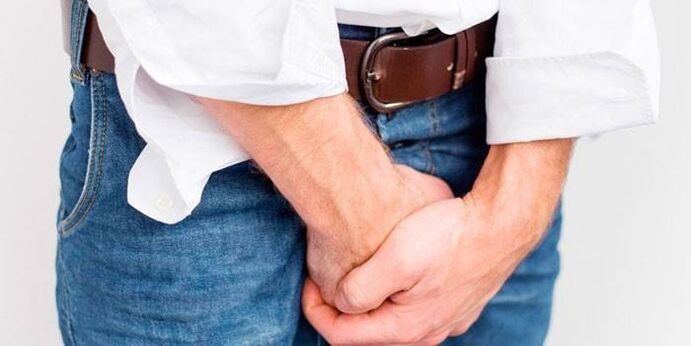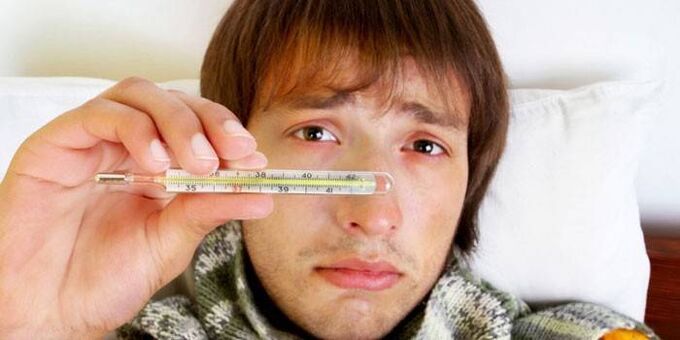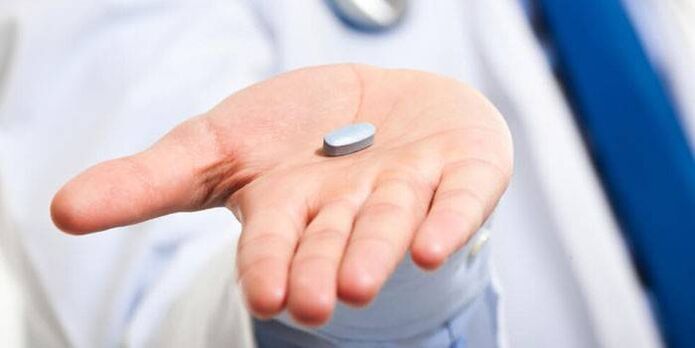Every second man of reproductive age (up to fifty years) is prone to such a delicate disease as acute prostatitis, in which under the influence of certain factors the prostate (prostate) becomes inflamed, causing various forms of sexual disorders. functions, fertility and psychoemotional states. Pay attention to what your body is telling you and don’t neglect timely treatment.
What is acute prostatitis
If a man feels discomfort and even pain while urinating, consult a doctor immediately, because acute prostatitis is a disease of infectious etiology that causes inflammation of the prostate, followed by edema of glandular tissue, creation of purulent foci. on it. If you do not pay attention to the signs of acute inflammation of the prostate, then the pathological process can turn into a chronic form that is difficult to treat, and time to think is very short - the transformation occurs in a few days.
However, more serious complications are possible than the transition to a chronic form. There is a risk of sepsis - a general blood infection and ascending urinary tract infection with the development of pyelonephritis and cystitis. In these cases, the patient is urgently hospitalized, the condition can be critical. Although sepsis as a complication is rare, it can occur in patients with immunosuppressive conditions - intoxication, fever, severe symptoms, weakness. Therefore, blood cultures are needed to detect microorganisms.
Symptoms of acute prostatitis
Every man should know and remember the symptoms of acute prostatitis. General signs of the disease are manifested:
- Sharp pain when urinating.
- Intoxication of the body.
- Urinary disorders (intermittent, weak, tense jet).
- Frequent need to visit the toilet at night.
These are external symptoms of prostatitis, but a deeper study reveals leukocytes in the urine, traces of mucus and pus in the secretory fluid of the prostate. On palpation, a dense, enlarged organ is felt, the pressure will be painful. Further development of the inflammatory process is characterized by heaviness and pain in the perineum that spreads to the penis, sacrum and rectum. As a result, the patient finds it difficult to empty the bladder and defecate due to severe pain. Body temperature can rise up to 38 ° C.

Causes of acute prostatitis
Because this disease is bacterial in nature, the causes of acute prostatitis are the following infectious agents:
- Gram-negative - Klebsiella, E. coli, Proteus.
- Gram-positive - enterococci, staphylococci, streptococci.
- Urogenital - trichomoniasis, chlamydia, ureaplasmosis, gonorrhea, candidiasis, mycoplasmosis.
The microbial microflora penetrates the glandular tissue of the prostate, as a rule, transcanalicularly (through the urethra and excretory ducts of the prostate). In cystitis, the infection migrates to the prostate from the bladder. Other possible routes for bacterial penetration are opened during endourethral manipulations (catheter placement, urethral buccal, cystoscopy, urethroscopy). Pathogenic microorganisms migrate to the prostate from distant pathogenic foci in caries, sinusitis, tonsillitis, cholecystitis, pyoderma, bronchitis.
There is a high probability of infection from the intestine with proctitis, hemorrhoidal fissures, colitis. Non-infectious factors that can cause an attack of prostatitis are congestive (congestive) venous phenomena in the pelvic region and impaired drainage of the acinus gland. Constipation can be caused by irregular or, conversely, excessive sexual activity, interruption of sexual intercourse, sedentary lifestyle, frequent constipation, frequent alcohol, varicose veins of the pelvis, hypothermia.
Forms of acute prostatitis
The clinical development of this disease is considered in three stages, which are also forms of acute pancreatitis. This is:
- The first stage is the catarrhal form.
- The second stage is the follicular form.
- The third phase is the parenchymal form.
Acute prostatitis in men begins with catarrhal inflammation, characterized by dilatation of the acinus, the appearance of edema of glandular tissue and, as a result, an increase in organ size. The excretory ducts of the prostate gland, which open into the posterior urethra, are actively involved in the inflammatory process. The lobules and ducts of the prostate become inflamed, their contractility is disturbed, they narrow and clog, which can make it difficult to secrete a secretory prostate.
In the catarrhal phase, the pathological process stops at the mucous layers and does not go deeper. In the process of progression, the disease spreads to the entire prostate. Follicular acute bacterial prostatitis developed. The analysis reveals pus in the urine. The glandular tissues change destructively, the swelling continues to increase. The follicular form is still susceptible to relatively easy treatment.
Furthermore, a parenchymal form of the disease develops, the outcome of which may be a prostate abscess or chronic prostatitis. Therefore, symptoms such as:
- Increase in body temperature to 39 ° C and above.
- Manifestations of intoxication: weakness, chills, thirst, lack of appetite.
- Frequent urges to the toilet for small needs are accompanied by pulsating sharp pains.
- Impossibility of emptying the bladder.
- Flatulence.
- Tennessee.
- Prison.
- Discharge of mucus from the anus.

Diagnosis of acute prostatitis
At the first suspicion of prostate inflammation, hurry to the doctor. Accurate and comprehensive diagnosis of acute prostatitis is very important for fast and successful treatment. The doctor will first analyze the anamnesis, clarify when painful sensations appear in the perineum, whether they increase or decrease during ejaculation, urination, defecation. Be sure that the doctor must study the patient's anamnesis: which diseases were transmitted, whether there were any sexually transmitted infections.
The urologist will palpate the external genital organs in order to determine developmental pathologies, visible signs of prostatitis and rectal examination - palpation of the prostate through the anus. To create a complete clinical picture, it is necessary to undergo the following examinations:
- Urine analysis to determine leukocyte levels and the presence of purulent threads.
- Blood test.
- Culture smear - the contents and scrapings are taken from the urethra to determine the growth of bacteria and their sensitivity to antibiotics.
- Determination of urine velocity (uroflowmetry).
- Prostate ultrasound to detect diffuse changes in the gland and the formation of its abscess.
- Blood test to determine the presence of pathogens diseases such as syphilis, gonorrhea, mycoplasmosis, chlamydia.
- PCR diagnostics.
Treatment of acute prostatitis
After a detailed diagnosis, they begin treatment for acute prostatitis. It is based on antibiotic therapy, the purpose of which is to suppress infectious pathogens. In addition, conservative treatment of prostatitis includes the use of:
- Anti-inflammatory drugs.
- Means that improve blood circulation.
- Pain medications and antispasmodics.
- Drugs that support metabolic processes in the prostate.
- Multivitamins.
- Phytotherapeutic agents.
- Immunomodulators.
Advanced forms of inflammation of the prostate with the appearance of purulent foci require surgical intervention. Transurethral (through the wall of the urethra) or transrectal (through the wall of the anus) drainage of abscesses is performed. Surgery may be needed in case of pathological urinary retention. A puncture epicystostomy is performed - an incision is made in the abdominal cavity into which a tube is inserted to divert urine.

drugs
Treatment of acute prostatitis in men with drugs (tablets, injections) is the basis of successful therapy. With well-prescribed antibiotic therapy, the infection can be overcome in a few days. However, it is recommended to continue the treatment for four weeks in order to achieve complete eradication of the pathogenic microflora. The drugs used in this disease are:
- Etiotropic (antibiotics) - destroy pathogens.
- Pathogenetic (NSAID) - elimination of congestion in the prostate.
- Symptomatic (analgesics, antipyretics) - relieves pain, muscle cramps and other symptoms.
To treat inflammation of the prostate, your doctor may prescribe a set of medications that will include:
- Injections - contribute to the penetration of the drug into body tissues in a short time.
- Candles (rectal) - analgesic, antibacterial effect.
- Instillations - delivery of the drug to the prostate through the urethral opening.
- Microclysters with herbal decoctions.
- Broad-spectrum antibacterial drugs, if no specific pathogen has been identified.
Antibiotics for acute prostatitis
The main causes of prostatitis are pathogenic bacteria that cause inflammation of the prostate tissue. Therefore, antibiotics for acute prostatitis are the basis of treatment and are prescribed only after testing for the sensitivity of the microflora. Antimicrobials used for inflammation are divided into the following groups:
- Fluoroquinolones.
- Penicillins.
- Cephalosporins.
- Macrolides.
- Tetracyclines.
- Aminoglycosides.
Prevention of acute prostatitis
In order for a man to always be healthy, full of strength, it is important to prevent acute prostatitis, including:
- Regular sex life with a regular partner, excluding casual relationships.
- Condom use.
- Stop smoking, drugs, alcohol.
- Proper nutrition.
- personal hygiene.
- Preventive annual examinations by a urologist.
- Taking vitamins and zinc preparations.
It is important to completely cure diseases of the genitourinary organs (urethritis, cystitis, pyelonephritis, balanoposthitis). Insufficiently treated diseases can cause the development of an inflammatory process in the prostate. Among other things, we must not forget to increase physical activity. Hypothermia should be avoided in the cold season. Prostate massage is very useful for men's health. However, if the disease has already been felt, massage is contraindicated and even impossible due to organ pain.



























